Top-down and bottom-up processing in sensation and perception
This post is part of a series of notes I collated during my studies at UCL’s Interaction Centre (UCLIC).
There are two general processes involved in sensation and perception. Bottom-up processing refers to processing sensory information as it is coming in. In other words, if I flash a random picture on the screen, your eyes detect the features, your brain pieces it together, and you perceive the image. What you see is based only on the sensory information coming in. Bottom-up refers to how we construct the image from the smallest sensory information pieces. Top-down processing, on the other hand, refers to perception driven by cognition. Your brain applies what it knows and what it expects to perceive and fills in the blanks.
What is data-driven or bottom-up processing?Permalink to section titled What is data-driven or bottom-up processing?
When an interpretation emerges from the data, this is called data-driven or bottom-up processing. Perception must be largely data-driven because it must accurately reflect events in the outside world. You want the interpretation of a scene to be determined mostly by information from the senses, not by your expectations.
What is schema-driven or top-down processing?Permalink to section titled What is schema-driven or top-down processing?
In many situations, however, your knowledge or expectations will influence perception. This is called schema-driven or top-down processing. A schema is a pattern formed earlier in your experience.
Larger scale or more abstract concepts are referred to as higher level, while concrete details (such as the input from the senses) are referred to as lower level. Top-down processing occurs any time a higher-level concept influences your interpretation of lower level sensory data.
What is set or expectancy?Permalink to section titled What is set or expectancy?
Top-down processing is shown by the phenomena of set or expectancy. A classic example is the Rat Man of Bugelski and Alampay (1961).
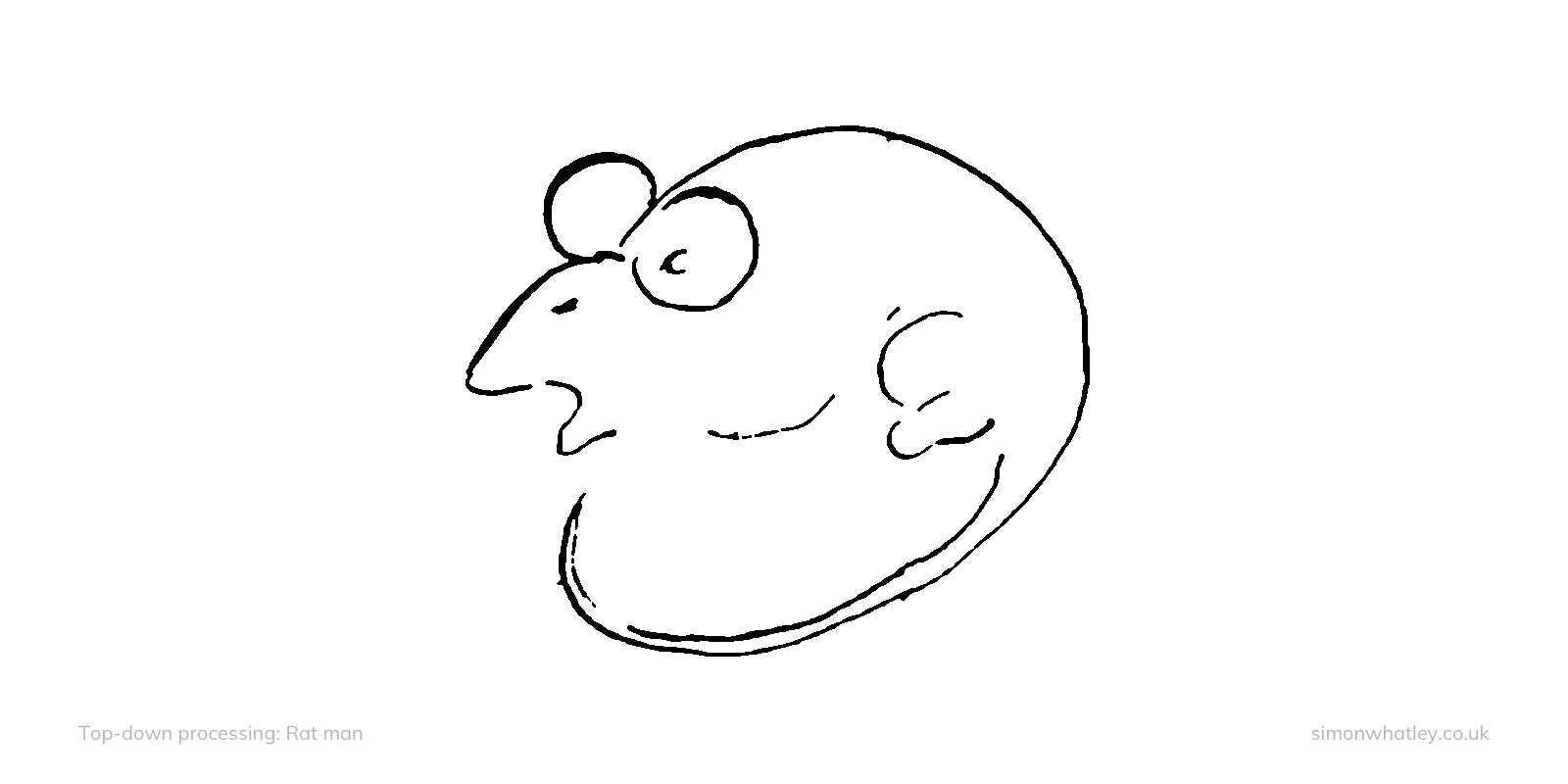
Figure 1: The Rat Man of Bugelski and Alampay (1961)
Subjects saw this picture after viewing earlier slides that showed line drawings of (1) animals, or (2) faces. Depending on whether they saw animals or faces in previous slides, subjects reported seeing either (1) a rat or (2) a man wearing glasses. They had been ‘set’ for one or the other interpretation by the preceding slides. This is a form of top-down processing, in which a schema influences interpretation of the data.
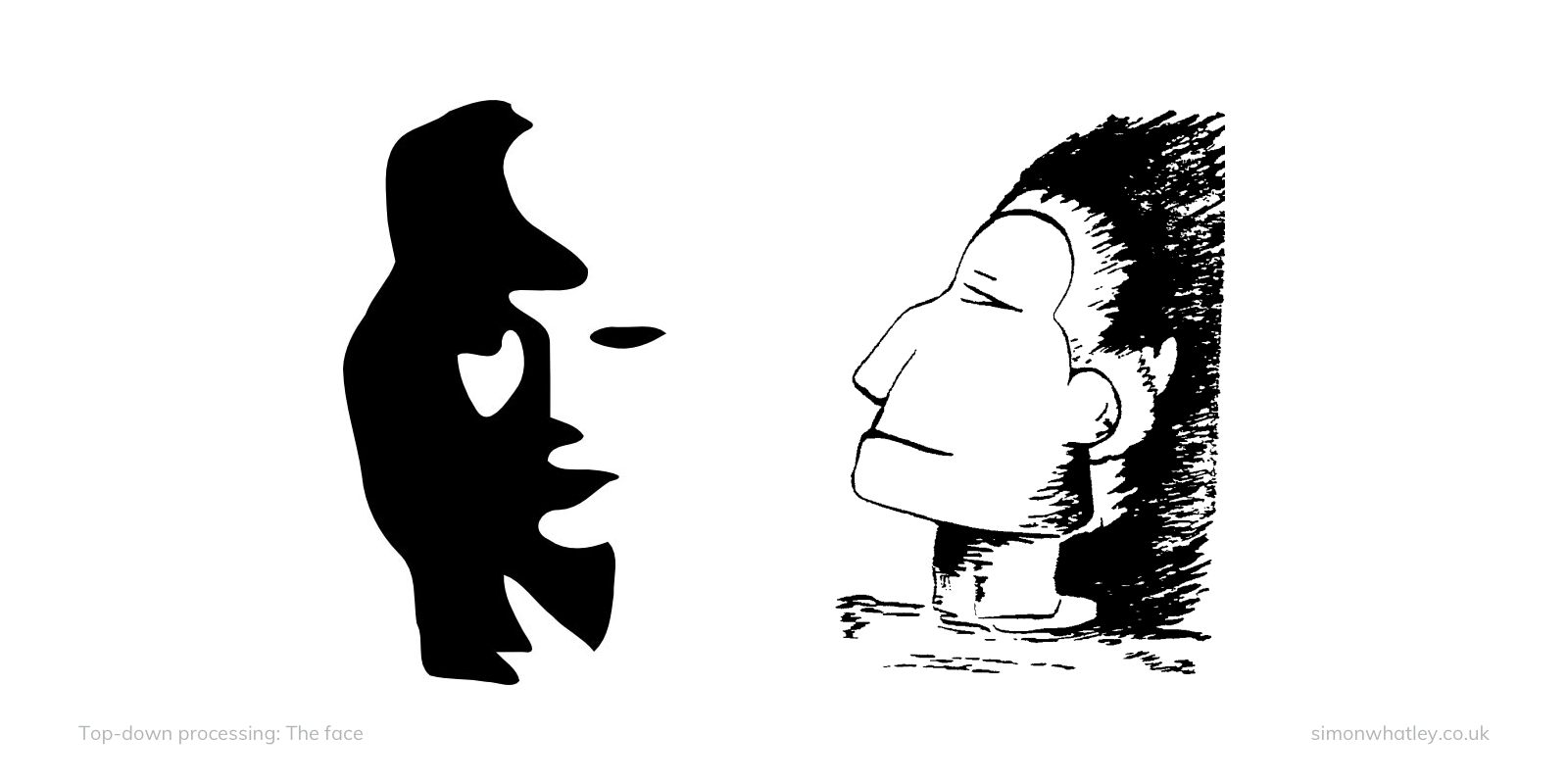
Figure 2: The face – your brain adds meaning what you perceive based on what it knows or expects.
Above is another example of top-down processing. From a bottom-up perspective, you should see a collection of meaningless blobs and lines. However, our brain is good at detecting faces, which, from a bio-sociological perspective, is among the most important stimuli in the world.
In the left image, the floating blob becomes an eye, and from the eye, we construct a nose and a mouth. The picture is labelled as “face” telling your brain what it is supposed to see. But there is an alternative. Instead of a face, look at the image again, and you will see a saxophone player wearing a big hat.
Similarly, the right image can either be interpreted as a face looking left, or an Eskimo figure entering a dark space.
You may have noticed that from the beginning, but for most, being told there is another image, will alert your brain to search for the pattern.
In what respect do cartoons rely upon top-down processing?Permalink to section titled In what respect do cartoons rely upon top-down processing?
Comics and cartoons provide many examples of top-down processing. Simple cues are used to suggest complex feelings and emotions. Cartoonists have a set of conventions for conveying information about mental and physical states. Tiny popping bubbles, for example, show drunkenness. Movement is shown by lines and little puffs of dust trailing after shoes. Spoken language is shown inside a bubble made out of a continuous line. A silent thought is shown inside a broken line. A sudden idea may be shown as a light bulb lighting up over a character’s head. Beads of sweat flying off a character show anxiety or physical exertion. After one gains some experience reading comics, these cues are processed automatically; one is hardly aware of them.
In what sense do we go “beyond the information given”?Permalink to section titled In what sense do we go “beyond the information given”?
In general, top-down processing—information processing based on previous knowledge or schemata—allows us to make inferences: to ‘perceive’ or ‘know’ more than is contained in the data. Little cartoon droplets do not contain the information that a character is working hard. We add that information based upon our previous experience and knowledge of the conventions of cartooning.
Jerome Bruner titled a book about cognitive development Beyond the Information Given (1972) He was acknowledging the pivotal role of inference in cognition. We go ‘beyond the information given’ constantly in our mental processes. We learn to add assumptions and supplemental information derived from past experience to the evidence of our senses, and that is how we make sense of our world
Top-Down and Bottom-Up ProcessingPermalink to section titled Top-Down and Bottom-Up Processing
Typically sensory input is considered ‘down’, and higher cognitive processes, which have more information from other sources, are considered up. A bottom-up process is characterised by an absence of higher-level direction in sensory processing, whereas a top-down process is characterised by a high level of direction of sensory processing by more cognition, such as goals or targets.
Cognitively speaking, certain cognitive processes, such as fast reactions or quick visual identification, are considered bottom-up processes because they rely primarily on sensory information, whereas processes such as motor control and directed attention are considered top-down because they are goal directed.
The study of visual attention provides an example. If your attention is drawn to a flower in a field, it may be because the colour or shape of the flower is visually salient. The information that caused you to attend to the flower came to you in a bottom-up fashion – your attention was not contingent upon knowledge of the flower; the outside stimulus was sufficient on its own.
Contrast this situation with one in which you are looking for a flower. You have a representation of what you are looking for. When you see the object you are looking for, it is salient. This is an example of the use of top-down information.
In cognitive terms, two thinking approaches are distinguished. Top-down (or ‘big chunk’) is stereotypically the visionary, or the person who sees the larger picture and overview. Such people focus on the big picture and from that derive the details to support it. Bottom-up (or ‘small chunk’) cognition is akin to focusing on the detail primarily, rather than the landscape. The expression “seeing the wood for the trees” references the two styles of cognition.
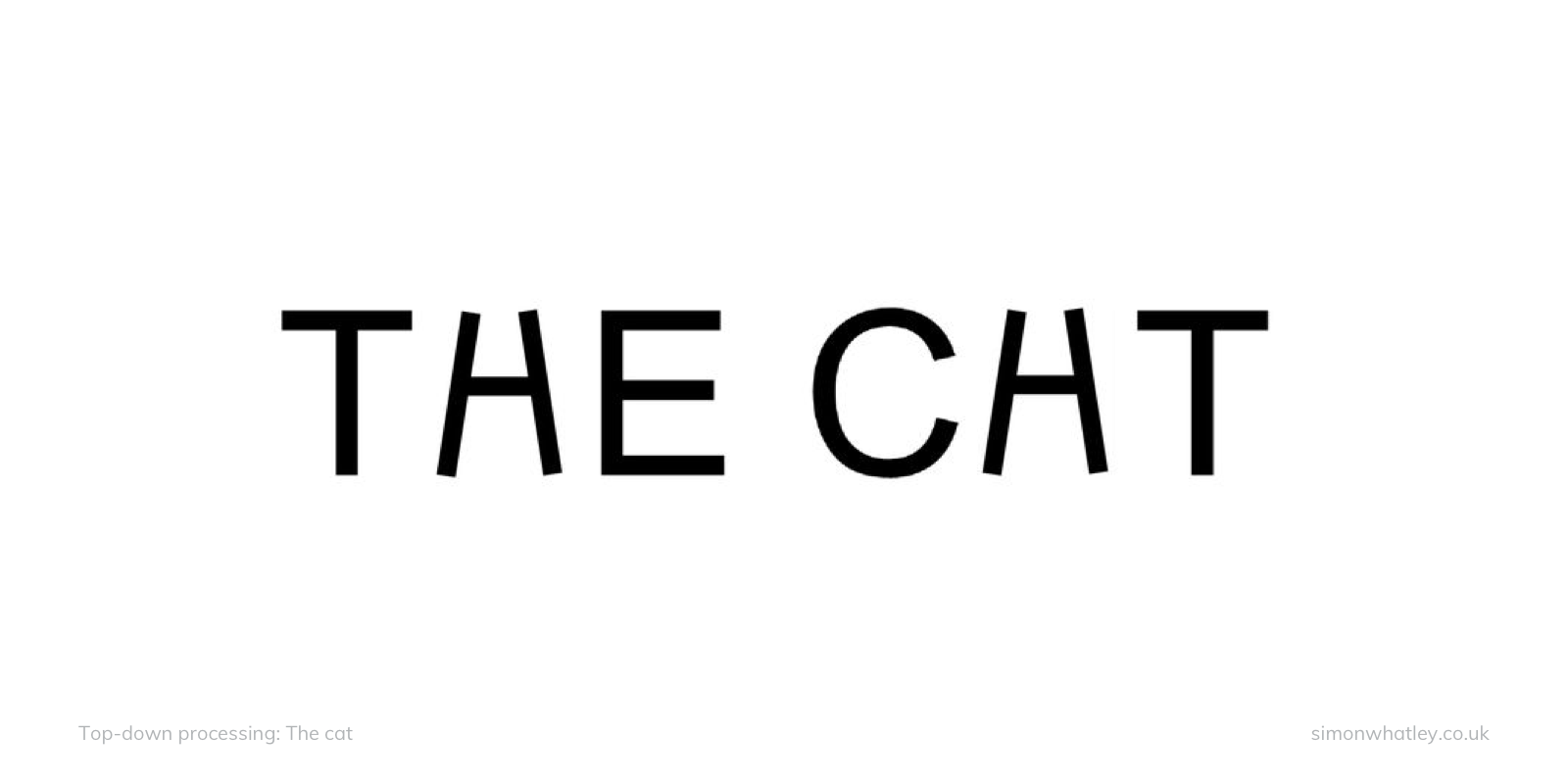
Figure 3: An example of top down processing: Even though the second letter in each word is ambiguous, top down processing allows for easy disambiguation based on the context.
Some other interesting examplesPermalink to section titled Some other interesting examples
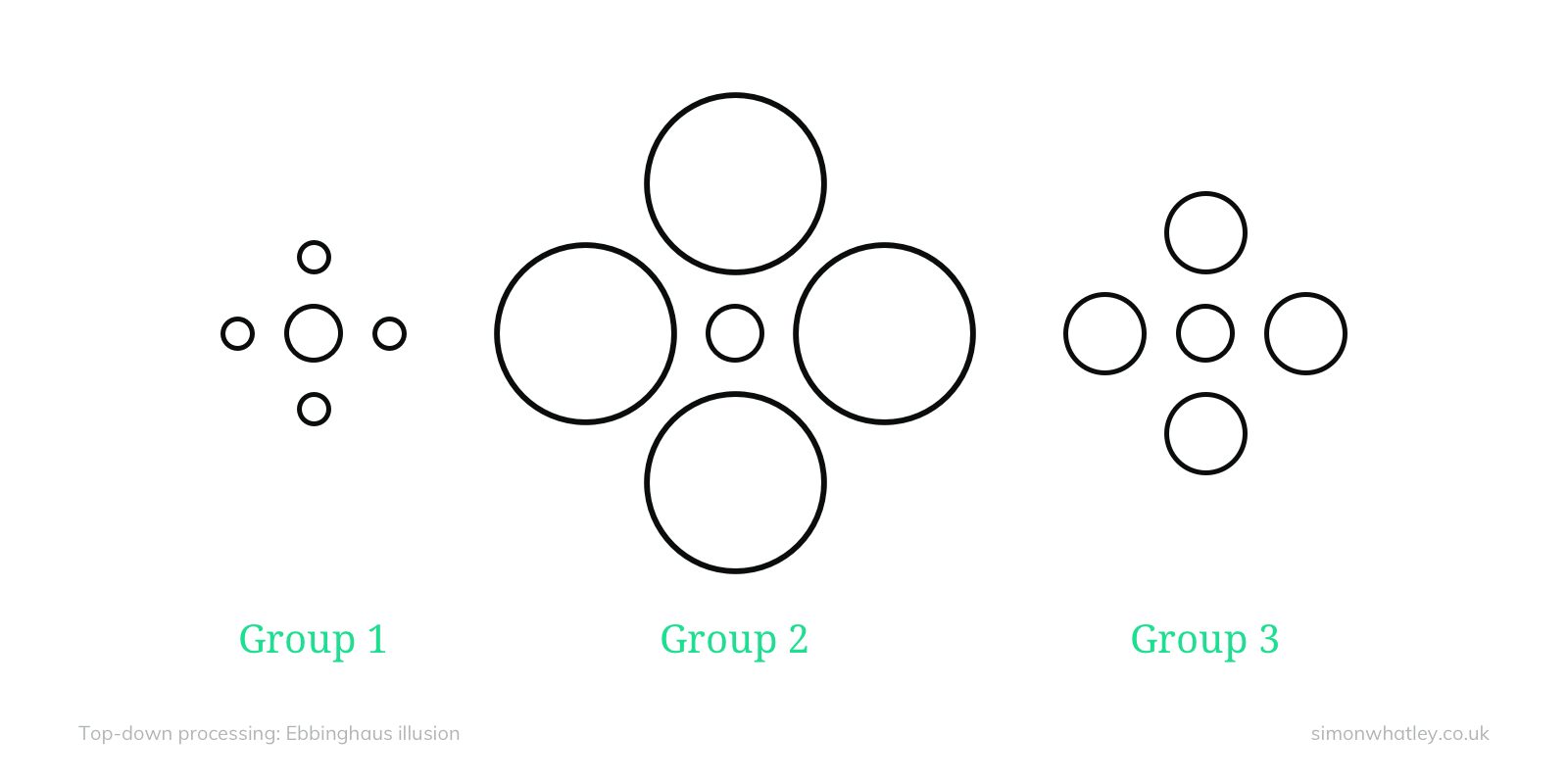
Figure 4: Ebbinghaus illusion
Perceptual comparisons typically produce contrast effects. The Ebbinghaus illusion, shown above, is a good example of a perceptual contrast effect. The centre circle is exactly the same size in Groups 1, 2 and 3, but it looks larger in Group 1 than in Group 2 because the circles that surround it are small in Group 1 and large in Group 2.
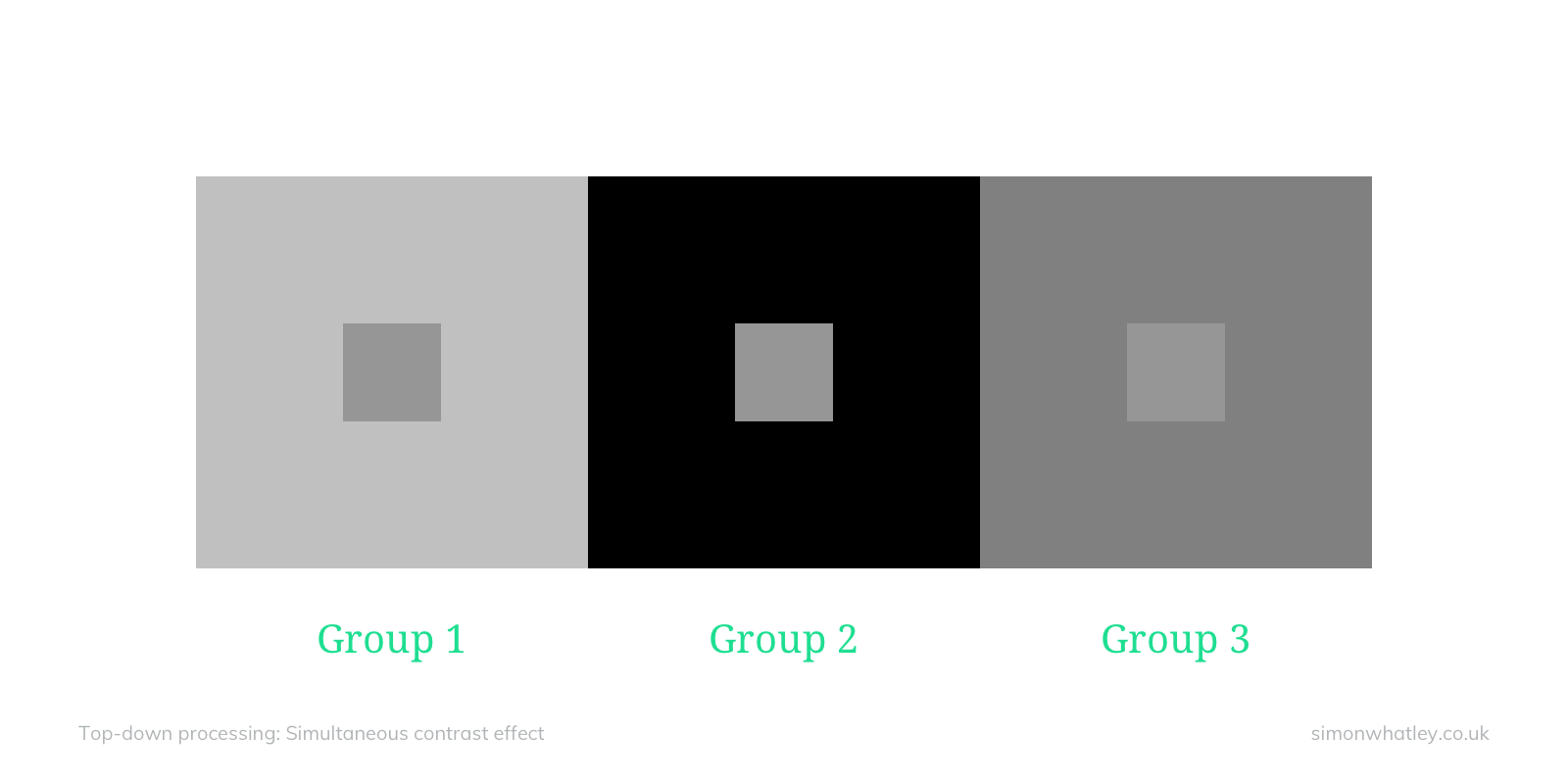
Figure 5: Simultaneous contrast effect
In the simultaneous contrast effect, the centre square appears lighter in Group 2 than in Group 3, because the difference again is larger in Group 2 than in Group 3.
References and further readingPermalink to section titled References and further reading
Updated on: 15 February 2021